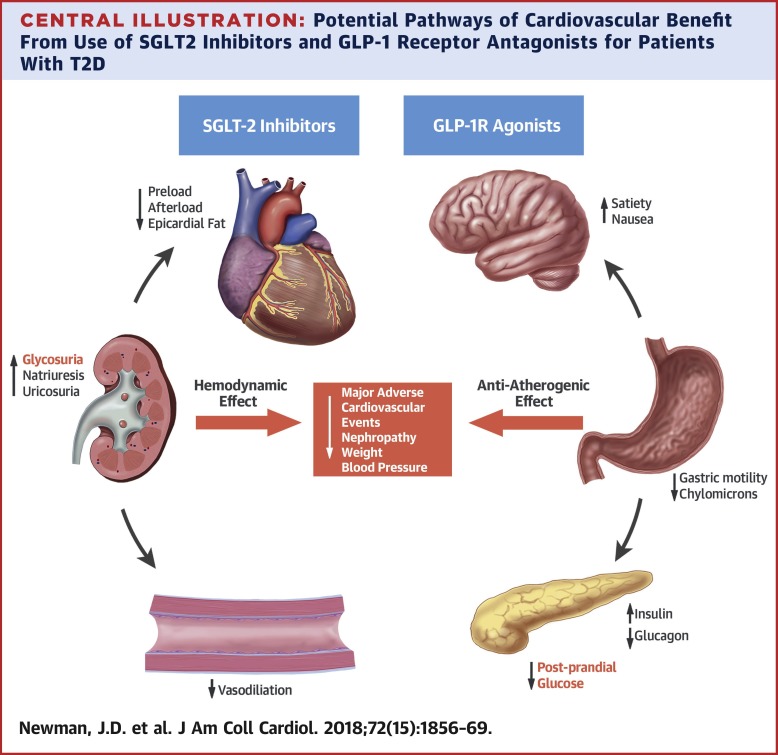当前位置:
X-MOL 学术
›
J. Am. Coll. Cardiol.
›
论文详情
Our official English website, www.x-mol.net, welcomes your
feedback! (Note: you will need to create a separate account there.)
The Changing Landscape of Diabetes Therapy for Cardiovascular Risk Reduction
Journal of the American College of Cardiology ( IF 21.7 ) Pub Date : 2018-10-01 , DOI: 10.1016/j.jacc.2018.07.071 Jonathan D Newman 1 , Anish K Vani 1 , Jose O Aleman 2 , Howard S Weintraub 1 , Jeffrey S Berger 1 , Arthur Z Schwartzbard 1
Journal of the American College of Cardiology ( IF 21.7 ) Pub Date : 2018-10-01 , DOI: 10.1016/j.jacc.2018.07.071 Jonathan D Newman 1 , Anish K Vani 1 , Jose O Aleman 2 , Howard S Weintraub 1 , Jeffrey S Berger 1 , Arthur Z Schwartzbard 1
Affiliation

|
Type 2 diabetes mellitus (T2D) is a major risk factor for cardiovascular disease (CVD), the most common cause of death in T2D. Despite improved risk factor control, however, adults with T2D continue to experience substantial excess CVD risk. Until recently, however, improved glycemic control has not been associated with robust macrovascular benefit. The advent of 2 new classes of antihyperglycemic agents, the sodium-glucose cotransporter-2 inhibitors and the glucagon-like peptide-1 receptor agonists, and their respective large cardiovascular outcome trials, has led to a paradigm shift in how cardiologists and heath care practitioners conceptualize T2D treatment. Herein, the authors review the recent trial evidence, the potential mechanisms of action of the sodium-glucose cotransporter-2 inhibitors and the glucagon-like peptide-1 receptor agonists, safety concerns, and their use for the primary prevention of CVD as well as in diabetic patients with impaired renal function and heart failure.
中文翻译:

降低心血管风险的糖尿病治疗格局的变化
2 型糖尿病 (T2D) 是心血管疾病 (CVD) 的主要危险因素,而心血管疾病是 T2D 死亡的最常见原因。然而,尽管风险因素控制有所改善,患有 T2D 的成年人仍然面临着严重的 CVD 风险。然而,直到最近,血糖控制的改善还没有与强大的大血管益处相关。两类新型抗高血糖药物(钠-葡萄糖协同转运蛋白 2 抑制剂和胰高血糖素样肽 1 受体激动剂)的出现,以及它们各自的大型心血管结果试验,导致心脏病专家和保健从业者的治疗方式发生了范式转变概念化 T2D 治疗。在此,作者回顾了最近的试验证据、钠-葡萄糖协同转运蛋白 2 抑制剂和胰高血糖素样肽 1 受体激动剂的潜在作用机制、安全性问题以及它们在 CVD 一级预防中的用途以及肾功能受损和心力衰竭的糖尿病患者。
更新日期:2018-10-01
中文翻译:

降低心血管风险的糖尿病治疗格局的变化
2 型糖尿病 (T2D) 是心血管疾病 (CVD) 的主要危险因素,而心血管疾病是 T2D 死亡的最常见原因。然而,尽管风险因素控制有所改善,患有 T2D 的成年人仍然面临着严重的 CVD 风险。然而,直到最近,血糖控制的改善还没有与强大的大血管益处相关。两类新型抗高血糖药物(钠-葡萄糖协同转运蛋白 2 抑制剂和胰高血糖素样肽 1 受体激动剂)的出现,以及它们各自的大型心血管结果试验,导致心脏病专家和保健从业者的治疗方式发生了范式转变概念化 T2D 治疗。在此,作者回顾了最近的试验证据、钠-葡萄糖协同转运蛋白 2 抑制剂和胰高血糖素样肽 1 受体激动剂的潜在作用机制、安全性问题以及它们在 CVD 一级预防中的用途以及肾功能受损和心力衰竭的糖尿病患者。






























 京公网安备 11010802027423号
京公网安备 11010802027423号